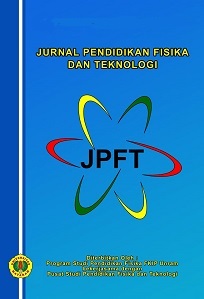The Effect of Problem-Based Learning on Grade XI Students' Creativity in Heat Topics
DOI:
10.29303/jpft.v10i2.8012Published:
2024-12-30Issue:
Vol. 10 No. 2 (2024): July - DecemberKeywords:
Heat, Creativity, Problem based learningArticles
Downloads
How to Cite
Downloads
Metrics
Abstract
This study aims to investigate the influence of the Problem-Based Learning (PBL) model on students' creativity in the topic of heat at SMAN 2 Praya. The study reveals that students' creativity in this topic is still low, caused by a lack of interest in lecture-based learning or other conventional methods. The PBL model, which integrates real-life problems, is expected to help students develop thinking skills and construct their knowledge independently. This research employs a quantitative approach with a quasi-experimental method. The population consists of Phase F, 11th-grade students at SMAN 2 Praya. The sample was selected using purposive sampling, with class F1-1 designated as the control group and class F1-2 as the experimental group. The data collection instrument was an essay test, tested for validity, reliability, difficulty level, and discrimination power. Data analysis was performed through normality, homogeneity, and hypothesis testing using the ANOVA test. The results indicate a significance value of 0.00, suggesting that the PBL model has a significant effect on improving students' creativity. This conclusion supports the implementation of PBL as an effective learning method to enhance students' creativity in the topic of heat.
References
Ahmad, Y. M., Mawarni, I. (2021). Kreativitas Belajar Peserta Didik pada Pembelajaran Pendidikan Agama Islam: Pengaruh Lingkungan Sekolah dalam Pengajaran. Jurnal Pendidikan Agama Islam Al-Thariqah, 6(2), 222-243.
Anggraini, T., Mustar, S., & Putri, D. P. (2020). Peningkatan Kreativitas Berpikir Peserta didik Dalam Implementasi Kurikulum 2013 Pada Pembelajaran Pai. Al-Mau'izhoh, 2(2), 362950.
Aristawati, N. K., Sadia, I. W., & Sudiatmika, A. A. I. A. R. (2018). Pengaruh Model Problem Based Learning Terhadap Pemahaman Konsep Belajar Fisika Peserta Didik SMA. Jurnal Pendidikan Fisika Undiksha, 8(1), 31-41.
Azizah, Z., Taqwa, M. R., & Assalam, I. T.(2020). Analisis Pemahaman Konsep Fisika Peserta Didik Menggunakan Instrumen Berbantuan Quizziz. Edusains Jurnal Pendidikan Sains & Matematika, 8(2).
Dewi, S. M., Harjono, A., & Gunawan, G. (2016). Pengaruh model pembelajaran berbasis masalah berbantuan simulasi virtual terhadap penguasaan konsep dan kreativitas fisika siswa SMAN 2 Mataram. Jurnal Pendidikan Fisika dan Teknologi, 2(3), 123-128.
Hastini, L. Y., Fahmi, R., & Lukito, H. (2020). Apakah Pembelajaran Menggunakan Teknologi dapat Meningkatkan Literasi Manusia pada Generasi Z di Indonesia?. Jurnal Manajemen Informatika (JAMIKA), 10(1), 12-28.
Hutabarat, H., Harahap, M. S., & Elindra, R. (2022). Analisis penerapan kurikulum merdeka belajar di SMA Negeri Sekota Padangsidimpuan. Jurnal MathEdu (Mathematic Education Journal), 5(3), 58-69.
Janah, M. C., Widodo, A. T., & Kasmui, K. (2018). Pengaruh model problem based learning terhadap hasil belajar dan keterampilan proses sains. Jurnal Inovasi Pendidikan Kimia, 12(1).
Melanie, T. S., Taufik, M., & Harjono, A. (2023). Problem-Based Learning Assisted by Mobile Pocket Book in Mechanical Wave to Enhances Students' Concepts Mastery and Creativity. Jurnal Pendidikan Fisika dan Teknologi, 9(2), 234-242.
Oktaviani, W., Gunawan, G.,& Sutrio, S. 2017. Pengembangan Bahan Ajar Fisika Konseptual Untuk Meningkatkan Penguasaan Konsep Peserta didik. Jurnal Pendidikan Fisika dan Teknologi. 3(1):1-7.
Robiyanto, A. (2021). Pengaruh model problem based learning terhadap hasil belajar siswa. Mahaguru: Jurnal Pendidikan Guru Sekolah Dasar, 2(1), 114-121.
Romadhon, D. W. S., & Imawan, M. R. (2024). Kemampuan komunikasi dan berpikir kreatif peserta didik pada materi organisasi kehidupan melalui penerapan model Project Based Lerning (PjBL). Proceeding Umsurabaya, 1(1).
Sugiyono. (2017). Metode Penelitian Kuantitatif, Kuantitatif dan R&D. Bandung: Alfabeta, CV
Author Biographies
Leza Puastri Putri, University of Mataram
Physics Education Study Program
Gunawan Gunawan, University of Mataram
Physics Education Study Program
Ahmad Busyairi, University of Mataram
Physics Education Study Program
Muhammad Taufik, University of Mataram
Physics Education Study Program
License
Copyright (c) 2024 Leza Puastri Putri, Gunawan Gunawan, Ahmad Busyairi, Muhammad Taufik

This work is licensed under a Creative Commons Attribution-ShareAlike 4.0 International License.
Authors who publish with Jurnal Pendidikan Fisika dan Teknologi (JPFT) agree to the following terms:
- Authors retain copyright and grant the journal right of first publication with the work simultaneously licensed under a Creative Commons Attribution License 4.0 International License (CC-BY-SA License). This license allows authors to use all articles, data sets, graphics, and appendices in data mining applications, search engines, web sites, blogs, and other platforms by providing an appropriate reference. The journal allows the author(s) to hold the copyright without restrictions and will retain publishing rights without restrictions.
- Authors are able to enter into separate, additional contractual arrangements for the non-exclusive distribution of the journal's published version of the work (e.g., post it to an institutional repository or publish it in a book), with an acknowledgement of its initial publication in Jurnal Pendidikan Fisika dan Teknologi (JPFT).
- Authors are permitted and encouraged to post their work online (e.g., in institutional repositories or on their website) prior to and during the submission process, as it can lead to productive exchanges, as well as earlier and greater citation of published work (See The Effect of Open Access).











